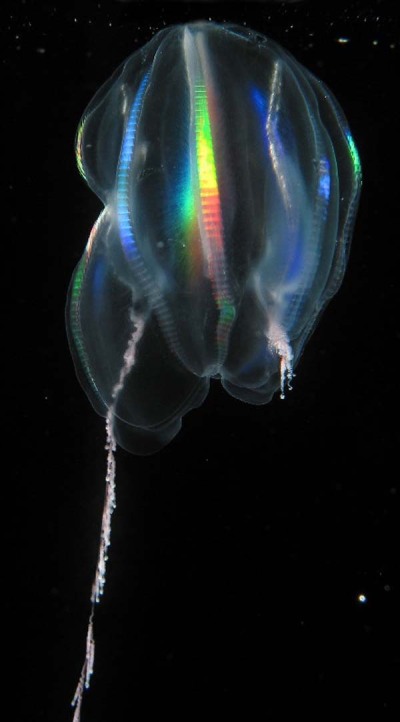Sea creature throws evolutionary view on digestive anatomy off balance

Scientists have long believed that comb jellies, otherwise known as ctenophores, ingest food and excrete waste through the same body opening. Through DNA analyses, they also know that these transparent marine creatures evolved earlier than jellyfish, sea anemones, and other animals that lack an anus, and much earlier than creatures with through-guts. However, they were stunned by a new discovery that comb jellies excrete waste through openings not their mouths.
This discovery somehow throws off balance the concept of ladder evolution in digestive anatomy, in which animals evolved from having one hole to having two.
"Looks like I've been wrong for 30 years," said marine biologist George Matsumoto to Science Magazine. "If people don't see this video, they won't believe it."
Matsumoto works at Monterey Bay Aquarium Research Institute in Moss Landing, California, and he was referring to the video presented by University of Miami's William Browne during the Ctenopolooza meeting in St. Augustine, Florida on March 15.
According the report by Science Mag, the evolutionary biologist showed a video of two species of comb jellies that he keeps in captivity, and he fed these trasluscent animals with genetically engineered zebrafish and crustaceans. These prey glow red with flouresent protein; thus, the scientist was able to observe as the food traveled through his subjects' bodies. This was captured using a sophisticated video setup, and what he discovered is that food particles that were not digested were excreted through pores in the comb jellies' rear and not through their mouths.
"This is a sphincterlike hole," he explained during the presentation, showing muscles that surround each ring.
There are theories regarding this new discovery, one of which is that, independent of other animals, comb jellies evolved these pores over millions of years on their own. Another one that Browne is looking into is, this may have evolved in an ancient ancestor but was lost in other animals that maintain one hole. If comb jellies do not activate the same genes for developing pores that other animals use in growing anuses, then this will indicate that the evolution of this body part is not a singular event.
 Christians don't have to affirm transgenderism, but they can’t express that view at work: tribunal
Christians don't have to affirm transgenderism, but they can’t express that view at work: tribunal Archaeology discovery: Medieval Christian prayer beads found on Holy Island
Archaeology discovery: Medieval Christian prayer beads found on Holy Island Presbyterian Church in America votes to leave National Association of Evangelicals
Presbyterian Church in America votes to leave National Association of Evangelicals Over 50 killed in 'vile and satanic' attack at Nigerian church on Pentecost Sunday
Over 50 killed in 'vile and satanic' attack at Nigerian church on Pentecost Sunday Ukrainian Orthodox Church severs ties with Moscow over Patriarch Kirill's support for Putin's war
Ukrainian Orthodox Church severs ties with Moscow over Patriarch Kirill's support for Putin's war Islamic State kills 20 Nigerian Christians as revenge for US airstrike
Islamic State kills 20 Nigerian Christians as revenge for US airstrike Man who served 33 years in prison for murder leads inmates to Christ
Man who served 33 years in prison for murder leads inmates to Christ


 Nigerian student beaten to death, body burned over ‘blasphemous’ WhatsApp message
Nigerian student beaten to death, body burned over ‘blasphemous’ WhatsApp message 'A new low': World reacts after Hong Kong arrests 90-year-old Cardinal Joseph Zen
'A new low': World reacts after Hong Kong arrests 90-year-old Cardinal Joseph Zen Iran sentences Christian man to 10 years in prison for hosting house church worship gathering
Iran sentences Christian man to 10 years in prison for hosting house church worship gathering French Guyana: Pastor shot dead, church set on fire after meeting delegation of Evangelicals
French Guyana: Pastor shot dead, church set on fire after meeting delegation of Evangelicals ‘Talking Jesus’ report finds only 6% of UK adults identify as practicing Christians
‘Talking Jesus’ report finds only 6% of UK adults identify as practicing Christians Mission Eurasia ministry center blown up in Ukraine, hundreds of Bibles destroyed: 'God will provide'
Mission Eurasia ministry center blown up in Ukraine, hundreds of Bibles destroyed: 'God will provide' Church holds service for first time after ISIS desecrated it 8 years ago
Church holds service for first time after ISIS desecrated it 8 years ago Burger King apologizes for 'offensive campaign' using Jesus' words at the Last Supper
Burger King apologizes for 'offensive campaign' using Jesus' words at the Last Supper Uganda: Muslims abduct teacher, burn him inside mosque for praying in Christ’s name
Uganda: Muslims abduct teacher, burn him inside mosque for praying in Christ’s name